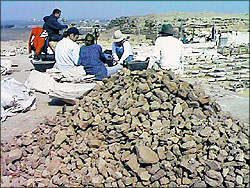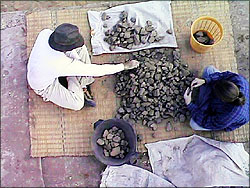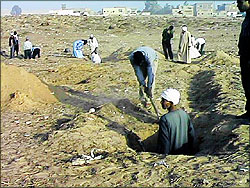
|
Newsflash
February 3, 1997: Mystery of the Bread Pot!
By Mark Lehner
 You who are checking into this web page may have heard of the
Internet-legendary secrets of the Giza Plateau. Now, with our colleagues at
the Supreme Council of Antiquities Giza Pyramids Inspectorate, we have
embarked upon an exploration of one of the deep dark secrets of the pyramids
- the mystery of the bread pot. In 1991 our search for the pyramid work
force led our excavating team about 300 meters south of the Sphinx and some 160
meters south of the 'Wall of the Crow,' where we uncovered two rectangular
rooms, about 5.25 by 2.75 meters each. It was an intact bakery where the
Egyptians of the Old Kingdom baked conical loaves in a pot that the ancient
tomb scenes label bedja.
You who are checking into this web page may have heard of the
Internet-legendary secrets of the Giza Plateau. Now, with our colleagues at
the Supreme Council of Antiquities Giza Pyramids Inspectorate, we have
embarked upon an exploration of one of the deep dark secrets of the pyramids
- the mystery of the bread pot. In 1991 our search for the pyramid work
force led our excavating team about 300 meters south of the Sphinx and some 160
meters south of the 'Wall of the Crow,' where we uncovered two rectangular
rooms, about 5.25 by 2.75 meters each. It was an intact bakery where the
Egyptians of the Old Kingdom baked conical loaves in a pot that the ancient
tomb scenes label bedja.
These may be the crudest kind of pottery that the Pyramid Age Egyptians
produced (they could do some really beautiful fine red polished sets of
dishes.) But the bell-shaped bread pots were made with walls nearly two
centimeters (almost an inch) thick, from a clay mixed with straw, chaff, and
even sand. They are sometimes so poorly fired that the great Giza excavator,
George Reisner, called it "mud ware." The bedja exterior has a rough surface,
with a ridge and a bulbous extra-thick round bottom. The ridge may have helped
the bakers stack heat the pots over an open fire, as shown in tomb scenes and
figurines, a pre-heating before baking, with the dough placed in one pot upside
down over another in egg-carton-like pits. The interior of a bedja is always
conical and smooth - the shape of the finished loaf. We think the potters made
bedja pots by hand over a cone of wood or stone.
Now that we have you hooked, and scrolling down for the next exciting line, we
have to say that we are not clear just why they made bread like this for about
500 years (from beginning of Egyptian historical period to end of the Old
Kingdom). An experimental replication of a bakery like those we discovered,
with the help of National Geographic, provided many insights, but profound and
impenetrable mysteries of the loaf remained. For example, what about the
workforce? Were these bakeries producing bread for pyramid builders? We know
that the bakeries were in full swing during the reign of the Pharaoh Menkaure,
builder of the Third Giza Pyramid. We also know he died before his pyramid was
completed, so workmen must have been nearby, within a couple throws of a stone,
during the operation of the bakeries. We know that with ancient Egyptian
barley and emmer-wheat flour, these were thick, massive, heavy loaves. But how
many could these two small bakeries feed, and how long were they producing?
 Ah! Therein lies the reason that our team member's hands and fingers are
chaffed, their knees sore, backs aching, jeans soiled with fine gray ashy
bread mold dust, their minds numbed by literally thousands, nay, tens of
thousands of bread mold shards. It is all because of A7/16, a large sample of
part of a deposit (feature 16) in the bakery area (7) of our
excavation area (A) that we excavated in our 1991 Winter season at the same
time as we cleared the bakeries. Even before we began A7/16, we knew this was
the "discard area," i.e. the dump from the bakeries during the time they were
in use. Feature (as we call any and all deposits in our excavation) number 16,
is, in fact, practically a bread-mold-sherd gravel, for the most part
concentrated bedja fragments, nearly a meter deep. There were so many we
took them away in large bags used for sand bags. At the time, we could only
sort, wash, and label one of every four bags. But we tend to be fairly
compulsive (perhaps the result of early childhood training) and we saved
everything.
Ah! Therein lies the reason that our team member's hands and fingers are
chaffed, their knees sore, backs aching, jeans soiled with fine gray ashy
bread mold dust, their minds numbed by literally thousands, nay, tens of
thousands of bread mold shards. It is all because of A7/16, a large sample of
part of a deposit (feature 16) in the bakery area (7) of our
excavation area (A) that we excavated in our 1991 Winter season at the same
time as we cleared the bakeries. Even before we began A7/16, we knew this was
the "discard area," i.e. the dump from the bakeries during the time they were
in use. Feature (as we call any and all deposits in our excavation) number 16,
is, in fact, practically a bread-mold-sherd gravel, for the most part
concentrated bedja fragments, nearly a meter deep. There were so many we
took them away in large bags used for sand bags. At the time, we could only
sort, wash, and label one of every four bags. But we tend to be fairly
compulsive (perhaps the result of early childhood training) and we saved
everything.
Storeroom space and administration is given by the good graces of the Giza
Inspectorate, and not only have they patiently assisted us in the retrieval
of this mass of material, they have stored it for these past four years, and
now they have made facilities available to capture from it whatever
information we are able so we can move on. So before digging anew, we are
sorting.
 We sort fragments of rims, bases, spouts, and handles from body parts of
vessels - not just bread pots, but other vessels that must have been used in or
near the bakeries. We sort bedja parts (usually fairly obvious) from parts of
other pots. We sort every sherd into a typology, or classification, of
different kinds of vessels, represented by a brick-work grid on the roof of
our storeroom. We count, we weigh, we try to estimate the actual number of
once-complete vessels these shards represent. John Nolan has worked out
procedures to estimate "minimum number of individuals." At the University of
Chicago, Justine Way investigates the evidence for how many times each bedja
may have been used - among other clues there is tell-tale layering in the
fracture, or break, of the bedja wall fragments that suggests multiple
heatings.
We sort fragments of rims, bases, spouts, and handles from body parts of
vessels - not just bread pots, but other vessels that must have been used in or
near the bakeries. We sort bedja parts (usually fairly obvious) from parts of
other pots. We sort every sherd into a typology, or classification, of
different kinds of vessels, represented by a brick-work grid on the roof of
our storeroom. We count, we weigh, we try to estimate the actual number of
once-complete vessels these shards represent. John Nolan has worked out
procedures to estimate "minimum number of individuals." At the University of
Chicago, Justine Way investigates the evidence for how many times each bedja
may have been used - among other clues there is tell-tale layering in the
fracture, or break, of the bedja wall fragments that suggests multiple
heatings.
From all this, we hope to derive an idea of how much bread for how many
people, over what period of time. Those sherds in the one-in-four gunny sacks
that were washed and labelled are not so unpleasant. But the 75% that are
unwashed are dusted with a gray ashy dirt, they have a rough texture, and,
while one bag may not be bad, after our hale and hearty team members have
sorted for hours (actually, going on four bedja-counting days now) in the sun
and wind, it takes it such a toll such that even the young (hardly
20's-something) Thomas Kittredge begins to look haggard. But he remains
inspired, so much so that last night he composed:
Ode to the Bread Molds
Oh, the bread molds, let me count the ways
Of why I hate to sort them, this task that wastes my days.
Oh, the colors they possess - gray, orange, and black.
I know that hunching over them, I'm screwing up my back.
Oh, how they are encrusted, layers of dust and dirt -
After sorting, you wouldn't guess, my earlier clean shirt.
Oh so many there to count, they stretch so wide and far -
In due time, they become the site of Tell el-Fukhar
[ed. note: "Mound of Pottery" in Arabic].
In spite of this, and for the record, it need be duly stated,
That sorting bread molds for Mr. Mark is quite underrated.
In fact, the same motivation for that last line prompted a literary
contribution on the subject from several team members, from which we can only
offer excerpts. Assistant Director John Nolan's began: "There are sherds and
shards, a gridded yard, with no space to spare, there they stand, bags
bulging hard, their labels God knows where!" And Jason Ur presented a more
formal essay: "The bread mold...dehumanized by the GPMP (Giza Plateau Mapping
Project), with the [type] label F2. This is the ancient Egyptian dixie cup.
Pack it with dough, stack it on the fire, pop out the bread, and consign the
bread mold to the dust heap."
 O.K., so you may think we are far from the mysteries of the pyramids. But not
really. Just as highly complex systems in many domains are built up from simple
structures and local rules, so great civilizations are generated from the
elementary structures of everyday life. Bread was basic to the ancient
Egyptians, and the way they organized their society to build the giant
pyramids is as intriguing as secret chambers and passages.
O.K., so you may think we are far from the mysteries of the pyramids. But not
really. Just as highly complex systems in many domains are built up from simple
structures and local rules, so great civilizations are generated from the
elementary structures of everyday life. Bread was basic to the ancient
Egyptians, and the way they organized their society to build the giant
pyramids is as intriguing as secret chambers and passages.
As we sort and count, our workmen still unfill the back-fill from our
excavation site - the sand with which we bury it to protect it from one
season to the next.
[Editor's note: Mark Lehner, Director of the excavation at Giza, will continue
to dispatch newsflashes to this website, as time allows, throughout the month
of February. Additional newsflashes will also be posted by Assistant Director
John Nolan.]
(previous newsflash)
(table of contents)
Photos: Carl Andrews
Pyramids Home | Pyramids | Excavation
Contents | Mail
|